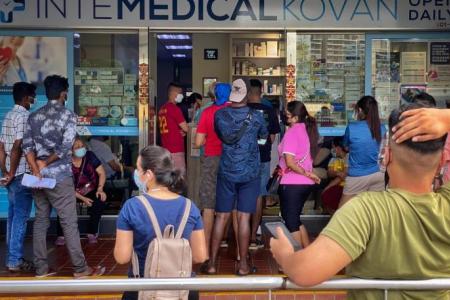Rising Covid-19 case numbers were expected, so why did MTF push back streamlining of measures?
Many have been left disappointed after the Multi-Ministry Taskforce (MTF) announced on Thursday (Feb 24) that the streamlining of safe management measures has been postponed.
The streamlining was to have taken place in two phases, starting Friday (Feb 25), according to initial plans unveiled last week.
The first round would have entailed allowing groups of five to visit homes at any one time, social gatherings of up to five persons at workplaces, adjustments to vaccination-differentiated measures for unvaccinated children aged 12 years and below, and the resumption of team sports.
More changes would have taken effect from March 4, affecting size limits for religious services, business events, media conferences, funerary memorial events, wedding receptions, and mask-on classes. Zoning would also no longer have been needed.
All these changes have now been pushed back to a date to be announced later.
The reasons for the delay: "Given the current surge in daily cases, and the extensive work involved in going through the detailed rules across different settings, the MTF has reviewed the matter and has decided to consolidate and streamline the SMMs in one go instead."
But people are asking: Surely the ministers knew there would be extensive work involved when they announced the changes on Feb 16?
Similarly, the high number of infections had been predicted.
When the streamlining was announced, Singapore was "seeing up to about 20,000 daily cases", which the MTF said was expected, given the high transmissibility of the Omicron variant. On Feb 24, when the delay was announced, there were 18,593 new cases.
Yet, on Feb 16 the MTF felt that the time was right to streamline measures since the situation in the healthcare system remained stable.
Yes, there was a surge to 26,000 cases on Tuesday (Feb 22), but the numbers have come down since. The total case numbers may be even higher early next week since it typically drops over the weekend and climbs on Tuesdays because of the reporting regime.
But those are not the important numbers, especially since many who are infected are not included in the daily count. What matters is the number of people who become seriously ill as that may impact the healthcare system. That number has remained fairly steady.
The MTF said on Feb 16 that there were about 1,400 Covid-19 patients in hospitals. This has gone up slightly and stood at 1,615 on Feb 24. There were 44 patients needing intensive care, a far cry from the high numbers last year. So the situation in hospitals remains fairly stable.
Associate Professor Alex Cook, a health modelling expert at the NUS Saw Swee Hock School of Public Health, said maintaining current measures "won't create a flat-topped wave, but the peak may not be as high and the impact to the health system may be marginally less".
Professor Ooi Eng Eong of Duke-NUS said lumping together people who test positive but have no symptoms along with those who are seriously ill "creates unnecessary alarm in many people".
He suggested Singapore follows the World Health Organisation's definition of Covid-19 which counts only those with "symptoms indicative of acute illness".
The way Singapore counts its numbers, he said, "confuses other countries, such as the United States Centres for Disease Control". On at least two occasions, the US CDC had wrongly concluded that Singapore's Covid-19 situation was out of control, and warned its people against travelling here.
Prof Ooi and other experts The Straits Times spoke to were equally surprised by the delay in streamlining measures, though they said that the trend of people rushing to hospital emergency departments after testing positive could have contributed to the decision.
This rush to get tested at hospitals will also push up case numbers.
Hospitals already face heavier than normal workloads with seriously-ill Covid-19 patients. There is needless extra stress when they need to augment staff to deal with people who are not sick, but turn up at the emergency department.
Professor Dale Fisher, a senior infectious diseases consultant at the National University Hospital (NUH), said: "The MTF has given its reasons for the delay and this is reasonable to accept, although the case numbers were known to be steadily rising, and the intricacies in removing restrictions would have been already understood."
He suggested that with the Omicron wave expected to peak soon, it might make sense to wait a little while so more measures could be eased at one go.
Said Prof Fisher: "It would certainly be easier to make broader and more positively impactful changes concurrently, and it's possible that we could see fewer steps to return Singapore life to normal.
"For example, instead of five visitors to your home changing to allow for more groups of five in one day, perhaps if we wait for the Omicron surge to end, we could remove the cap on visitors altogether."
Prof Ooi added that some changes "may need to be done simultaneously as a step-by-step approach may paradoxically worsen the burden on our healthcare system".
Prof Cook pointed out: "Most countries where the Omicron wave had peaked, relaxed measures only after their peak. However it's worth pointing out that many of those countries did so quite aggressively, because of the overwhelming fatigue caused by their measures."
But he warned the peak of the wave is also the time when hospitals will be seeing more cases, "so it makes sense to wait until after the peak to start relaxing measures, rather than to accelerate into the peak".
Get The New Paper on your phone with the free TNP app. Download from the Apple App Store or Google Play Store now


